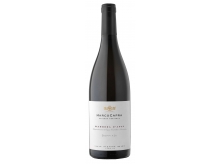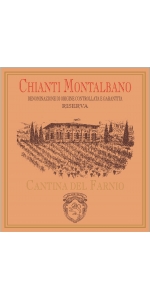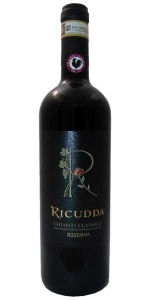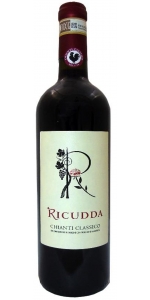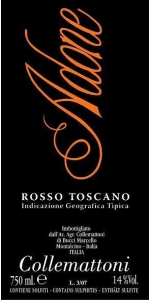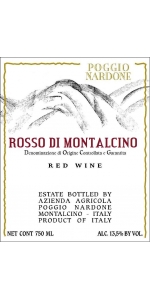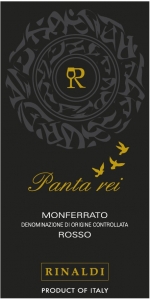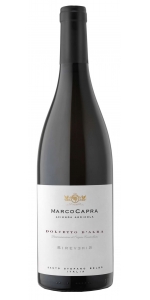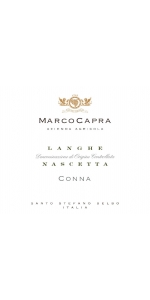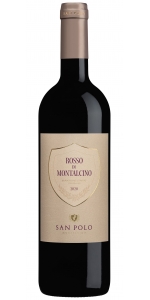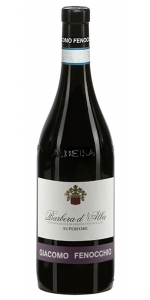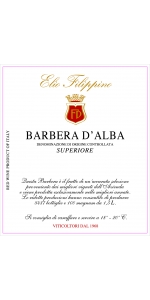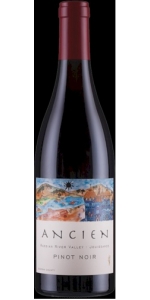Capra Marco Doppiadi Barbera d'Asti 2021
6 bottles with free shipping for: $180.00
12 bottles with free shipping for: $300.00
| BUY MORE! SAVE MORE! | ||||||||||||||||||||
|
| Country: | Italy |
| Region: | Piemonte |
| Winery: | Marco Capra Azienda Agricola |
| Grape Type: | Barbera |
| Organic: | Yes |
| Vintage: | 2021 |
| Bottle Size: | 750 ml |
Capra Marco Doppiadi Barbera d'Asti is made from 100% Barbera.
Color: very deep bright ruby red with violet hues.
Bouquet: intense and persistent, pleasantly fruity and reminiscent of plums and black cherries.
Flavor: vinous, full, pleasantly fresh and generous.
Suitable as an aperitif with appetisers and sliced meats, it is perfect throughout a meal. it is perfect with pasta dishes featuring tagliatelle and ravioli, as well as with meaty main courses, such as stews and roasts. Interesting with medium-mature cheeses, with Toma and Pecorino.
The estate is located in Santo Stefano Belbo, on the Seirole
hill between the Langhe and Monferrato districts. The main resource of the area
has always been the cultivation of the vine: the particular geological
conformation of the soil and its microclimate favor an optimal ripening of the
bunches and the acquisition of the typical organoleptic properties.
This is a small family-run company; the art of viniculture
is a wealth that the family has handed down for generations. The quality that
distinguishes the wine is determined by the control on the entire supply chain
from the vine to the bottle, through processes that follow the tradition while
promoting the innovation that distinguishes modern companies.
Today the company is managed by Marco Capra who has
succeeded in giving the right innovative boost typical of the new generations,
while continuing to observe the teachings and experience handed down by his
forefathers. The precious consulting skills of the oenologists Dante Scaglione
and Daniela Serra is a further guarantee for the production of the very best
quality wines.
Date Founded: 1945
Owner: Marco Capra
Winery Philosophy: "Wine is a piece of Art. We
make wine as artists create their artworks. We give voice to the grapes,
exalting them with our expertise."
Tommaso Capra, known as “Tumasin”, founded the estate in the hills of Santo
Stefano Belbo in 1945. Tommaso then handed down his experience and winemaking
culture to his son Luciano. Until the end of the 1980s, the primary activity of
the estate was the production of high quality wine sold in traditional
demijohns to the wholesalers.
In 1999 Marco, Luciano’s grandson, took over the company,
giving new energy to the business. Driven by a real passion for wine and an
aspiration to renewal and his youthful enthusiasm, Marco has carried on the
family tradition and contributed to its growth.
In 2014 Marco Capra decided to change the name “Azienda
Agricola Sanmarco” and started using his own name Marco Capra directly onto the
label to highlight his personal “touch”. The convincing result is visible in
the wines, which fully express the typicity of the territory and have succeeded
in gaining the increasing appreciation of both wine experts and wine
enthusiasts.
Winery Acreage: 44.5 acres
Winery Production: 5,000 / 9L cases
Varietals Produced: PINOT NOIR, CHARDONNAY, MOSCATO,
NASCETTA, DOLCETTO, BARBERA, NEBBIOLO
Winemaker: Marco Capra
Marco Capra was born in 1981 in Asti and has been living in
Santo Stefano Belbo since his birth. He started working with his grandfather
for a couple of years when he was 18. From 1996 to 1998 he learned to work the
land and the vineyards, while in 1999 he started working fulltime at the
winery. In 2001 the winery was renovated and in 2014 he personalized the name
of the label after his name. He is married to Monica and is a father of two
lovely kids of 7 and - Elisabetta and Riccardo.
Producing high quality wines is Marco Capra’s first goal,
and in order to achieve this, his personal commitment and work start in the
vineyard: “The vineyards are our most important capital and it is our job to
take care of them and work them in the most natural and eco-compatible way
possible”. Piedmont is renowned for its typical, richly traditional grape
varieties – Nascetta, Nebbiolo, Dolcetto, Barbera and Moscato.
The hills that give life to Marco Capra wines are those of
Langhe, Roero and Monferrato, a wonderful marriage between nature and man’s
work recognized as UNESCO World Heritage Site in 2014. From the top of the
Seirole hill in Santo Stefano Belbo; Marco enjoys a spectacular view on the
vineyards which are perched on the gentle slopes, with the best exposition to
the sun’s rays and the breeze from the wind. The terroir is special, very rich
and able to give life to the great wines of the Piedmontese heritage.
Marco Capra Azienda Agricola produces mainly Piedmont’s
autochthonous wines to enjoy all the characteristics of the terroir. The
vineyards were chosen in the areas that are most suited to the cultivation of
the single grape varieties. Meticulous care and attention are given to the
vines, in the respect of agriculture techniques that allow to keep the yield
under control. Defensive treatments are carried out prioritizing products with
a low environmental impact.
The beginning of the harvest is decided by observing the degree of ripeness of
the grapes, their sugar and acid contents and their development over time on
the basis of the atmospheric conditions. The harvest usually starts at the end
of August, with the Chardonnay and Pinot Noir grapes for sparkling wines,
whereas Moscato, Chardonnay and Nascetta grapes are harvested at the beginning
of September. Dolcetto and Barbera grapes are harvested between the end of
September and the beginning of October followed, in mid October, by Nebbiolo grapes.
The grapes are all harvested by hand, into small perforated crates. All the
phonological phases and the work in the vineyard are supervised by the
agronomist Angelo Cortese.
The cellar
The wine is born in the vineyard, but man is responsible for trying to best
transform the fruit that he receives after months of hard work in the vineyard.
The architectural structure and all the technical systems have been designed
and built to obtain the transformation of the grapes to the highest possible
levels.
The cellar is equipped with all the latest technology, yet it remains faithful
to the most traditional vinification processes.
Every step of the winemaking process - from the arrival of the grapes to
fermentation, maturation, bottling, aging and shipping - is supervised by Marco
Capra who, flanked by the oenologists Daniela Serra and Dante Scaglione,
oversees every single phase in order to achieve the best final result.
This is a small family-run company; the art of viniculture is a wealth that the family has handed down for generations. The quality that distinguishes the wine is determined by the control on the entire supply chain from the vine to the bottle, through processes that follow the tradition while promoting the innovation that distinguishes modern companies.
Today the company is managed by Marco Capra who has succeeded in giving the right innovative boost typical of the new generations, while continuing to observe the teachings and experience handed down by his forefathers. The precious consulting skills of the oenologists Dante Scaglione and Daniela Serra is a further guarantee for the production of the very best quality wines.
Date Founded: 1945
Owner: Marco Capra
Winery Philosophy: "Wine is a piece of Art. We make wine as artists create their artworks. We give voice to the grapes, exalting them with our expertise."
Tommaso Capra, known as “Tumasin”, founded the estate in the hills of Santo Stefano Belbo in 1945. Tommaso then handed down his experience and winemaking culture to his son Luciano. Until the end of the 1980s, the primary activity of the estate was the production of high quality wine sold in traditional demijohns to the wholesalers.
In 1999 Marco, Luciano’s grandson, took over the company, giving new energy to the business. Driven by a real passion for wine and an aspiration to renewal and his youthful enthusiasm, Marco has carried on the family tradition and contributed to its growth.
In 2014 Marco Capra decided to change the name “Azienda Agricola Sanmarco” and started using his own name Marco Capra directly onto the label to highlight his personal “touch”. The convincing result is visible in the wines, which fully express the typicity of the territory and have succeeded in gaining the increasing appreciation of both wine experts and wine enthusiasts.
Winery Acreage: 44.5 acres
Winery Production: 5,000 / 9L cases
Varietals Produced: PINOT NOIR, CHARDONNAY, MOSCATO, NASCETTA, DOLCETTO, BARBERA, NEBBIOLO
Winemaker: Marco Capra
Marco Capra was born in 1981 in Asti and has been living in Santo Stefano Belbo since his birth. He started working with his grandfather for a couple of years when he was 18. From 1996 to 1998 he learned to work the land and the vineyards, while in 1999 he started working fulltime at the winery. In 2001 the winery was renovated and in 2014 he personalized the name of the label after his name. He is married to Monica and is a father of two lovely kids of 7 and - Elisabetta and Riccardo.
Producing high quality wines is Marco Capra’s first goal, and in order to achieve this, his personal commitment and work start in the vineyard: “The vineyards are our most important capital and it is our job to take care of them and work them in the most natural and eco-compatible way possible”. Piedmont is renowned for its typical, richly traditional grape varieties – Nascetta, Nebbiolo, Dolcetto, Barbera and Moscato.
The hills that give life to Marco Capra wines are those of Langhe, Roero and Monferrato, a wonderful marriage between nature and man’s work recognized as UNESCO World Heritage Site in 2014. From the top of the Seirole hill in Santo Stefano Belbo; Marco enjoys a spectacular view on the vineyards which are perched on the gentle slopes, with the best exposition to the sun’s rays and the breeze from the wind. The terroir is special, very rich and able to give life to the great wines of the Piedmontese heritage.
Marco Capra Azienda Agricola produces mainly Piedmont’s autochthonous wines to enjoy all the characteristics of the terroir. The vineyards were chosen in the areas that are most suited to the cultivation of the single grape varieties. Meticulous care and attention are given to the vines, in the respect of agriculture techniques that allow to keep the yield under control. Defensive treatments are carried out prioritizing products with a low environmental impact.
The beginning of the harvest is decided by observing the degree of ripeness of the grapes, their sugar and acid contents and their development over time on the basis of the atmospheric conditions. The harvest usually starts at the end of August, with the Chardonnay and Pinot Noir grapes for sparkling wines, whereas Moscato, Chardonnay and Nascetta grapes are harvested at the beginning of September. Dolcetto and Barbera grapes are harvested between the end of September and the beginning of October followed, in mid October, by Nebbiolo grapes.
The grapes are all harvested by hand, into small perforated crates. All the phonological phases and the work in the vineyard are supervised by the agronomist Angelo Cortese.
The cellar
The wine is born in the vineyard, but man is responsible for trying to best transform the fruit that he receives after months of hard work in the vineyard. The architectural structure and all the technical systems have been designed and built to obtain the transformation of the grapes to the highest possible levels.
The cellar is equipped with all the latest technology, yet it remains faithful to the most traditional vinification processes.
Every step of the winemaking process - from the arrival of the grapes to fermentation, maturation, bottling, aging and shipping - is supervised by Marco Capra who, flanked by the oenologists Daniela Serra and Dante Scaglione, oversees every single phase in order to achieve the best final result.
Farnio Chianti Montalbano Riserva is made from 90% Sangiovese, 5% Canaiolo and 5% Colorino.
Brilliant ruby red with plain ruby shades, fairly clear. Blackberry and violet notes emerge on the nose with spiced and vegetal tones, leading to a leathery and pencil lead finish. Elegant, pleasant, pure and intense aromas but vigorous and round. Slightly tannic and fresh, balanced and full-bodied.
Wild boar in sauce, grilled meat, casseroles, game and mature pecorino cheese.
Ricudda Chianti Classico Riserva 100% Sangiovese.
Deep ruby red color.
The wine shows an intense and persistent bouquet, with notes of berries and spices such as licorice and black pepper. Well-harmonized hints of oak.
In the mouth, it is well structured and balanced, complex, persistent with notes of red fruits and spices such as black pepper and licorice.
Pair with grilled red meats, steak, game of hair and feather, stewed and roasted, aged cheeses hard like pecorino.
Intense ruby red color with purple tints.
On the nose, the wine shows some intense notes of red fruits, especially cherry and slight hints of oak.
In the mouth, it has a good structure, great softness and it is pleasant to drink. Predominant notes of red fruits, with slight spiciness.
Pair with first courses with game, grilled meats, fresh and aged cheeses such as pecorino.
Collemattoni Adone Rosso Toscano is made from 95% Sangiovese and 5% Merlot
ruby red in color, bouquet of violet, cherry and blackberry, pleasant, dry and well balanced mouthfeel.
Coming from a parcel with 5-8 year old vines planted in sandy clay and marl soils.
Harvest is 100% destemmed with a soft pressing, fermentation in stainless steel tanks at controlled temperature of 28-30°C, maceration for 10 days.
Malolactic fermentation completed.
Wine is slightly filtered before bottling.
Poggio Nardone Rosso di Montalcino is 100 percent Sangiovese Grosso.
Intense ruby red color with garnet tints.
Intense and delicate aromas of fresh fruits with notes of cherry.
Dry red wine with a good strength and freshness, along with a nice aromatic persistence.
The 5 hectares of specialized vineyards in Montalcino are at an altitude of 350 meters above sea level and are surrounded by woodlands of ilex, oak and arbutus which are characteristic of Montalcino’s hillside habitat. The soil is predominantly composed of marl and limestone which renders this terrain particularly rich in mineral salts.
Pairs well with pasta prepared with meat sauces, mushrooms or truffles; complex rice, main courses of pork or veal with sauces.
Review:
"Aromas of red fruit, rosemary and white smoke. Medium-bodied with bright acidity. Pleasant, savory herbs on the palate. Wet-stone finish. Drink now."
- James Suckling (September 2021), 90 points
Rinaldi Panta rei Monferrato Rosso is a blend of 50% Barbera and 50% Cabernet Sauvignon.
This wine is quite tasty, smooth, silky and powerful.
It is loaded with dried red fruit notes from the appassimento of the grapes and it also has a lot of spicy aromas and flavors from the oak ageing.
Grown on limestone soils.
The average age of the vines is 30 years old.
10% of the wine is appassimento. Appassimento is an Italian term for drying harvested grapes, traditionally on bamboo racks or straw mats, for a few weeks up to several months to concentrate the sugars and flavors. This process is used in making Amarone, Recioto and Sforzato.
This drying method is not traditional in Piemonte but is popular in other part of Italy like in the Veneto region.
Thanks to this new method the wine is rounder and softer, boasts beautiful notes of red dried fruits.
Pantarei is aged 14 months in French oak ((the wood is Allier, medium toast) barrels and 6 months in bottle before release.
Delicious with wild game, grilled meat and strong cheese.
Capra Marco Sireveris Dolcetto d'Alba is made from 100% Dolcetto.
Color: deep, bright ruby red with violet hues.
Bouquet: vinous, fruity and fragrant, with notes reminiscent of ripe cherries.
Flavour: full, dry flavour with a pleasantly bitter aftertaste, typical of this variety.
A wine for drinking throughout a meal, it is perfect with cured meat and cheese snacks, ideal with rice and pasta dishes or with red meat, all combinations which enhance its delightful suitability for drinking.
Marco Capra Langhe Nascetta is made from 100% Nascetta - 15 years old - 1.73 acres
Aged 6 months in stainless steel vats
The name "CONNA" is a sweet nickname after his wife Monica.
Bright straw yellow with greenish hues, with an intense and interesting perfume of grapefruit, apple and aromatic herbs. Floral, fresh, focused, good acidity. Refreshing and bright, full bodied with an aromatic persistence, it is savory and tasty on the palate with a smoothness that enhances the rich character of the wine
Altitude: 400 m above sea level.
Soil composition: lime and sand.
Plant density: 5000 vines / hectare.
Cultivation system: traditional Guyot.
Yield per hectare: 6 tons.
After a short period of maceration on skins, the grapes are soft pressed. The clear must obtained ferments slowly in stainless steel vats at a controlled temperature of 16-17°C. The wine spends a long period of time on the fine lees, with frequent “batonnage”
Ideal with apetizers, shellfish and other fish dishes.
Bright and glossy ruby red in color. On the nose it reveals aromas of small fresh berries and a trace of sour cherry, melded with hints of blackberries and black cherries, followed by a hint of vanilla. A fragrant wine with satisfying intensity. On the palate it is warm, smooth and a medium-bodied with finely-balanced tannins. Dry and sinewy yet fresh with a persistent, aromatic finish.
It naturally accompanies dishes that are typical of Tuscan cuisine with its bold, authentic flavors, such as pasta and risottos made with mushrooms or truffles, pork, grilled meats and medium-matured cheeses.
Review:
Notes of ripe cherries, dried flowers and walnuts with hints of anisette and licorice. Medium- to full-bodied, compact and dense with creamy tannins and steady acidity. Weighty and structured. Drink or hold.
-James Suckling 91 Points
Fenocchio DOC Barbera d'Alba Superiore Bussia is made from 100 percent Barbera.
The color is a deep ruby red with garnet reflections. It has a rather intense bouquet, with scents typical of the vine and a full bodied and dry flavor, with a distinct and pleasing acidity. It becomes mature with aging, acquiring a full and balanced flavor.
Parcel is 2.5 hectares (6.2 acres) planted at 300 meters above sea level.
It pairs well with red and white meats, tagliatelle pasta and cheeses.
Filippino Elio Barbera d'Alba Superiore is made from 100% Barbera.
This 100% Barbera shows an intense fruity bouquet with subtle vanilla and toasty notes. Full and spicy flavors, and a good body.
The grapes are pressed and the stalks are removed. The must ferments at about 26°C for 6-9 days. After racking, before the end of fermentation, the new wine is put in 225 liter Allier barriques for long months, depending on the vintage and the wine’s structure. It is subsequently moved into stainless steel vats to rest for some months before bottling.
Ancien Pinot Noir Russian River Jouissance is made from 100 percent Pinot Noir.
Jouissance is sourced from the single vineyard established and farmed by Mark Lingenfelder at his home estate. Mark’s decades of experience as a vineyard manager and consulting viticulturalist have provided him the depth of experience to reach the pinnacle at his own property. Having worked with storied wineries over the years, we are grateful our paths have crossed enabling us to work with him for our Russian River designate. He tends the vines himself while relying on neighbor Lee Martinelli to provide additional help at the peak times. We work with a mix of Pommard and Dijon 667 vines from his oldest and youngest blocks – aged wisdom combines with youthful vigor!
The 2021 growing season was a welcome success after a more varied and challenging 2020. The vines came on with aplomb, demonstrating the rich fruit concentration we expect – even if the crop was meager. The ongoing drought in California served to further accentuate the character and concentration of the fruit. While warmer conditions have prevailed in other areas, the coastal areas of California continue to benefit from the maritime influence and moderating influence that it brings.
We fermented in our one ton, open-top tanks after filling by gravity. A warm fermentation with a combination of native and isolated Burgundian yeasts produced excellent and focused flavor extraction, complemented with traditional punch-downs by hand. The wine was aged entirely in Francois Freres cooperage, 40% new, and racked once, gently, prior to bottling. Grapes, must, and wines were moved using gravity through to the barrel and using inert gas through racking and bottling. 151 cases produced.
Bright fruit notes dominate the aromas with bright cherry, plum, and boysenberry underlaid by allspice and clove. On the palate the wine is liquid velvet, it’s silkiness segueing into a burst of fruit and spice that rides high on the palate while gradually opening to deeper berry, tea, and baking spices. It is a refreshing and lively Pinot Noir in its youth that will continue to fill out in depth and complexity over the next 2-5 years.
- back
Lokoya Spring Mountain Cabernet Sauvignon is made from Napa Valley Cabernet Sauvignon.
Review:
The 2018 Cabernet Sauvignon Spring Mountain District is a monster of a mountain Cabernet that has a primordial bouquet of blackcurrants, smoked earth, chocolate, and graphite. While Spring Mountain wines tend to be more aromatic and complex right out of the gate, that’s not the case here, and this is going to need bottle age to round into form. Full-bodied on the palate, with a rich, concentrated mouthfeel, it has serious tannins, notable purity of fruit, and a great finish. With air, it picks up more and more classic Spring Mountain floral and exotic notes, and it’s flawlessly balanced, with gorgeous tannins and a great, great finish. This is a brilliant wine in the lineup and unquestionably one of the true gems from Spring Mountain in 2018. Give bottles 4-5 years and enjoy over the following 2-3 decades.
-Jeb Dunnuck 98 Points
Ferren Pinot Noir Sonoma Coast is made from 100 percent Pinot Noir.
100% native fermentation (primary and secondary), long cool fermentations often lasting up to a full year, minimal lees stirring, no additions of any kind (commercial yeast, water, acid, enzymes, etc., never any fining or filtration). Aged 18 months in 15% new French oak (Francois Freres, Vosges, Troncais Forrests)
Review:
A lovely and balanced wine that is pleasurable and complex. Spices, cherries, dried cranberries, mixed berries, bramble fruit, black truffles and forest floor. Salty minerality and orange zest in the finish. Medium body. Drink now.
-James Suckling 94 Points

